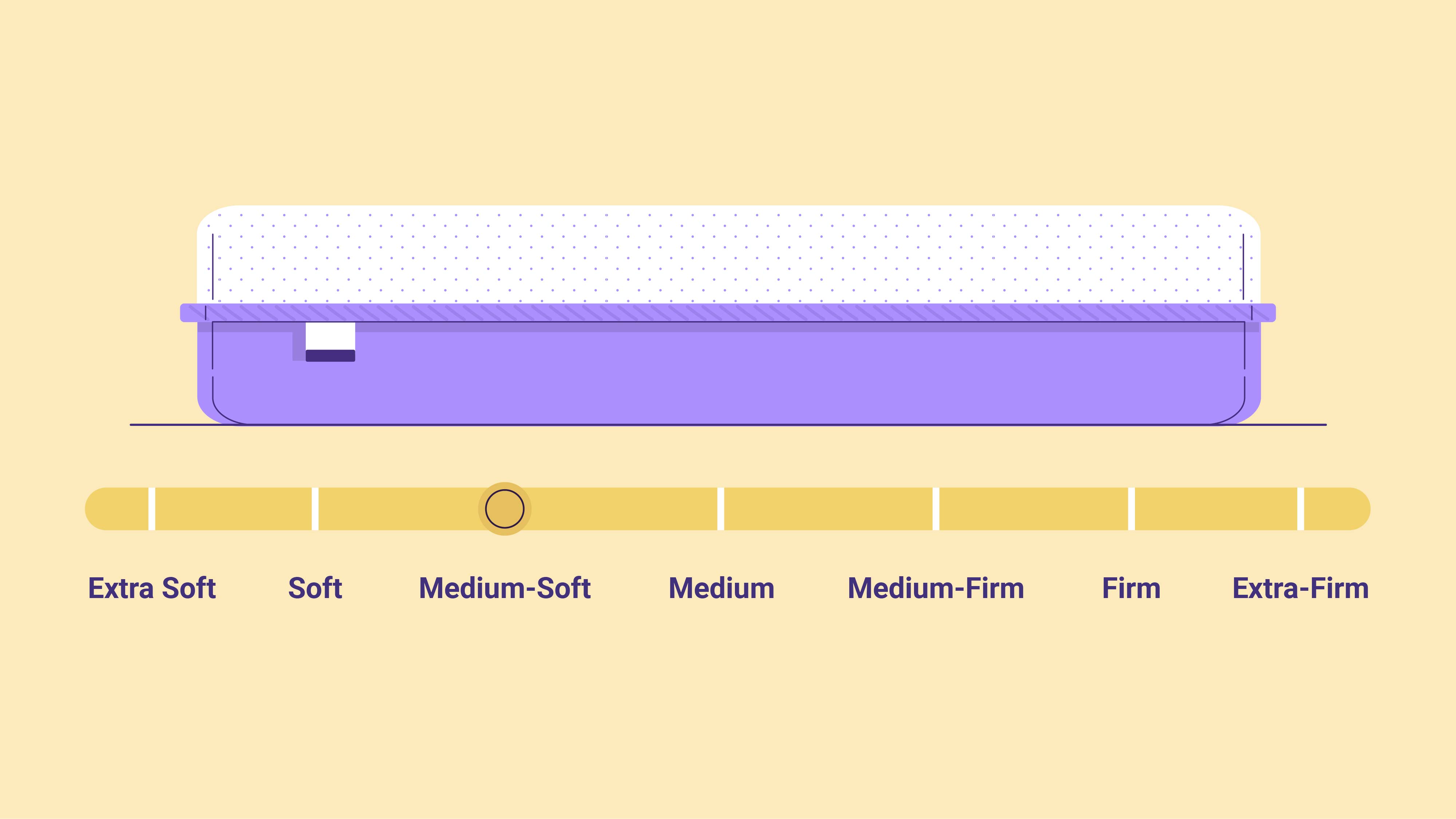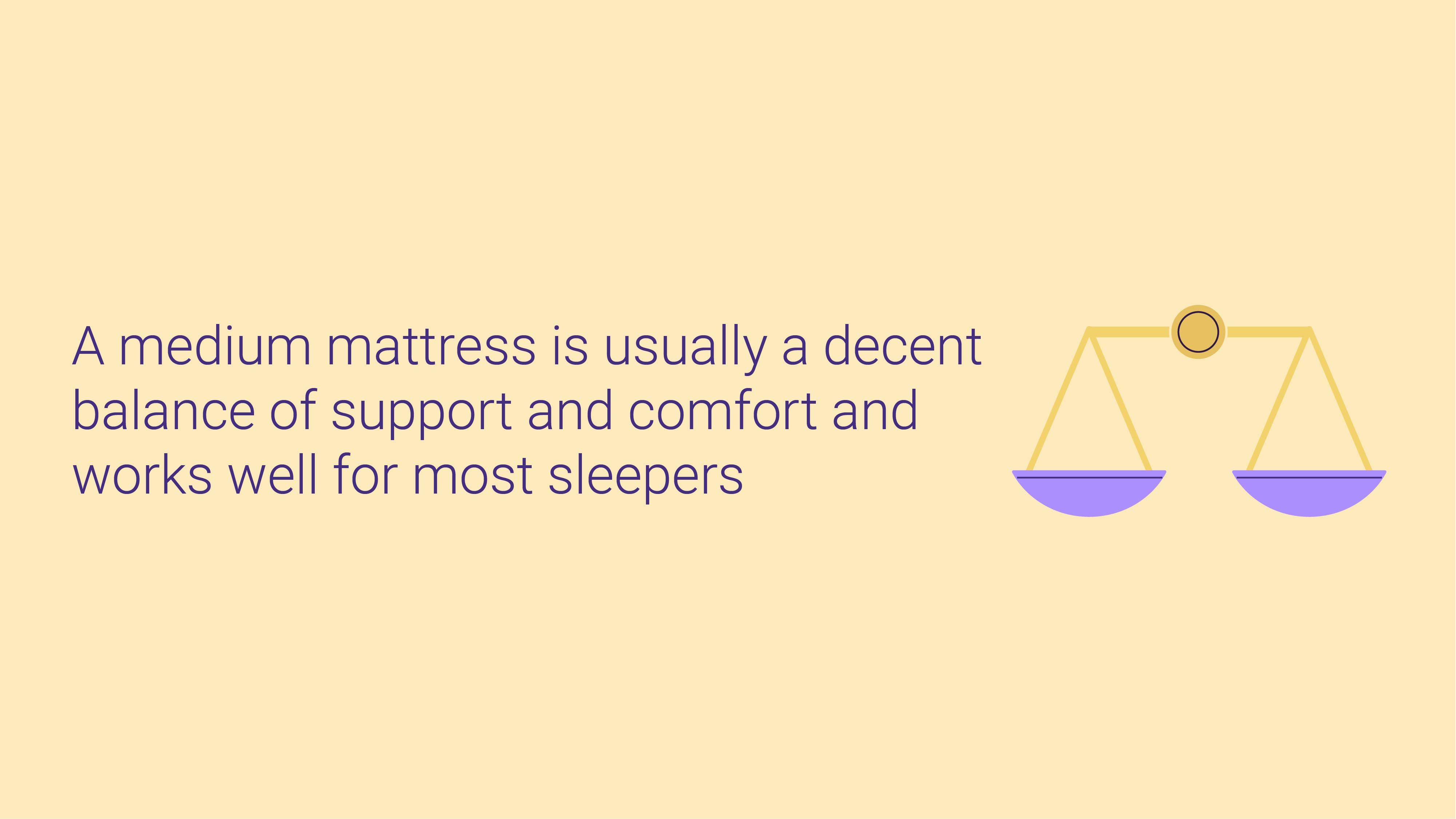
Mattress Firmness Scale & Guide

Mattress firmness refers to a mattress’s cushioning and is one of the most important factors to consider before deciding to purchase a new bed. The firmness impacts the initial feel of your bed and the amount of pressure relief it provides.
Most mattress brands use a scale from 1 to 10 to describe mattress firmness, with 1 being the softest and 10 being the firmest. Choosing the right firmness level comes down to your personal preferences to an extent, but it mainly depends on your sleep position and body weight.
We detail every mattress firmness as well as how you can find the optimal firmness for you based on your sleeping position, size, and whether or not you share your bed.
Mattress Firmness Scale
| Firmness | Firmness Scale | Ideal Users |
|---|---|---|
| Soft | 1-2 | Petite individuals and side sleepers |
| Medium-Soft | 3-4 | Petite individuals, side sleepers, and combination sleepers |
| Medium | 5-6 | Petite individuals, back sleepers, combination sleepers, and couples |
| Medium-firm | 7-8 | Plus-sized individuals, individuals with back pain, back sleepers, and stomach sleepers |
| Firm | 9-10 | Plus-sized individuals and stomach sleepers |
Soft (1-2)
Soft mattresses are a 1 to 2 on the mattress scale and offer the most cushioning compared to all other mattresses. Soft mattresses hug your body closely and sink deeply.
A soft mattress is usually best for petite and side sleepers. Side sleepers need the extra cushioning to prevent pressure points on the stomach and hips, while petite sleepers need a softer bed to properly cushion the body since it doesn’t put as much pressure on the bed.
Still, there’s such a thing as too much contouring and sinkage. For this reason, very soft mattresses are usually uncommon. Most softer mattresses are actually around a medium-soft than a true soft.
Medium-Soft (3-4)
Medium-soft mattresses are a 3 to 4 on the firmness scale and much more common than soft mattresses. A medium-soft mattress still contours closely to your body, but is sturdier and has a thinner comfort layer than a soft mattress so you won’t sink and feel stuck in bed.
Medium-soft mattresses are a good option for individuals who need cushioning to prevent pressure build-up, but also don’t want to feel stuck in their bed, like they can on a soft mattress. In general, medium-soft mattresses work well for side sleepers and petite adults.
Medium (5-6)
Medium mattresses are a 5 to 6 on the mattress firmness scale and provide an excellent balance of support and cushioning. They’re a very common mattress firmness because they suit so many different people. Even brands with minimal mattress options will almost always offer a medium mattress.
For those of us who tend to change positions at night, medium mattresses are supportive enough to accommodate multiple positions but aren’t so cushiony that they are hard to move.
Medium beds also make the best mattresses for couples with different body types and sleep positions. Medium mattresses are also still soft enough for petite individuals to use comfortably.
Medium-Firm (7-8)
Medium-firm mattresses are a 7 to 8 on the firmness scale and provide enough cushioning for you to sleep comfortably without sinking.
In most cases, back sleepers are most comfortable on a medium-firm bed. Also, if you weigh more than 230 pounds, a medium-firm mattress is firm enough so you won’t sink in your bed. Along with this, if you struggle with chronic back pain, medium-firm mattresses are a good choice to soothe your discomfort.
Firm (9-10)
Firm mattresses are as stiff and firm as beds come. They have very thin comfort layers and thick base layers.
Just like extra soft beds (1), extra firm beds (10) are rare. Extra firm mattresses are a bit too stiff for most people and can potentially cause you to develop pains, aches, and pressure build-up. Standard firm mattresses (9) are more common.
Some people may see the word “firm” and assume that means uncomfortable, but firm beds can be comfortable. Your comfort on a firm bed comes down to your size and sleeping position.
Larger sleepers typically need a firmer sleep surface to support their body and prevent the bed from bottoming out. Similarly, back and stomach sleepers need a firm bed to prevent their lower backs and spines from sinking and throwing their spines out of alignment.
Finding the Best Mattress Firmness for You
When buying a mattress, it can feel challenging knowing what firmness to choose, but it’s not complicated. Let’s take an in-depth look at how to choose a mattress with the firmness for you.
Sleeping Position
How you sleep has the biggest impact on the mattress firmness you need. Your sleep position impacts your potential pressure points and pain as well as the amount of contouring you’ll need to be comfortable.
- The right mattresses for side sleepers are those with a medium-soft to medium firmness. The thick comfort layers should adequately cushion the shoulders and hips, two areas susceptible to pressure points when side sleeping.
- Mattresses for back sleepers should be medium to medium-firm. The balance of cushioning and support promotes proper spinal alignment without causing too much sinking.
- The right beds for combination sleepers are medium or medium-firm. The balanced feel of both mattresses will do a sufficient job of supporting most sleeping positions.
- Mattresses for stomach sleepers should be medium-firm or firm. Firmer mattresses are sturdy so your hips won’t sink and cause lower back pain.
Weight
Your weight affects the amount of pressure you place on your bed and how the bed feels beneath you. Therefore, lightweight and heavy sleepers require a different level of support. Most mattress companies base their firmness rating on the average-sized person who weighs between 130 to 230 pounds. If you’re not an average-sized adult, it may be unclear which firmness you need, but we’re here to help.
The right beds for petite adults, those less than 130 pounds, are softer than what’s recommended for their sleeping position. Conversely, the best mattresses for heavier sleepers, those 230 pounds or more, are firmer than what’s recommended for their sleeping position.
For example, if you’re a petite adult and need a medium-firm mattress, a medium mattress will feel like a medium-firm mattress beneath you.
Sleeping Partner
If you share a bed, you have to consider your partner’s needs, too, especially if they have different firmness needs. This can ensure you’re both comfortable.
The best mattress size for couples is arguably a split king size mattress so both you and your partner can choose different firmness levels and won’t need to worry about motion transfer.
However, split king mattresses can get expensive and require specific accessories, so this isn’t an option for everyone.

A medium mattress is usually a decent balance of support and comfort and works well for most sleepers.
What’s the Difference Between Firmness and Support?
Although firmness and support may seem interchangeable, they’re not the same thing. Firmness impacts the feel of your bed, while support refers to how well your bed aligns your spine.
A common misconception is that soft mattresses are unsupportive and sag quickly while firm mattresses are uncomfortable and stiff. A high-quality soft mattress can be supportive and durable, while a high-quality firm mattress can be comfortable.
So, when looking for a mattress, don’t assume firmness and support are the same. Keep both in mind to ensure your mattress is both supportive and comfortable.
FAQs
What is “universal comfort”?
Some brands describe their mattresses as “universally comfortable,” though this usually means the mattress is around a medium or medium-firm firmness (5 to 8 on the firmness scale).
A universal comfort mattress may be tempting because it can take the stress out of choosing a mattress firmness, but there’s not a “one size fits all” mattress. Although medium and medium-firm mattresses provide a balance of comfort and support, you may need more or less support and cushioning.
What is the best firmness for a mattress?
There is not one best firmness for a mattress because firmness is subjective. The best firmness for you depends on your body type and sleeping position. From there, you can find the optimal firmness for you.
How do I know if my mattress is too soft or too hard?
There are several signs you should look out for to determine whether or not your current mattress is too firm for you:
- You wake up with back, shoulder, or hip pain
- You wake up feeling exhausted
- Your arms and hands feel numb or tingly
- Your mattress doesn’t contour to your body
Similarly, here are the signs that your mattress is too soft for your needs:
- You struggle to get comfortable to fall asleep
- You feel your bed bottoming out when you lie down
- You wake up with a sore lower back or neck
- You feel trapped in your bed
- It’s difficult getting in and out of bed
Do mattresses get softer over time?
Yes. Now, this doesn’t mean your new mattress will get drastically softer over only several months of use. Instead, when your mattress ages after several years of use, it will soften, grow lumpy, and you’ll eventually need to replace it.
Your mattress’s lifespan will depend on the type of mattress you have—memory foam latex, hybrid, etc—though mattresses typically last between 7 to 10 years. With this in mind, your mattress’s firmness does not affect its lifespan.
Are soft mattresses bad for you?
A soft mattress is not bad for you so long as it’s a suitable firmness for your body and needs. On the other hand, an old mattress that has gone soft, lumpy, and saggy is bad for you because it’s worn down and unsupportive, not necessarily because it’s soft.
Conclusion
The main elements to consider when shopping for a new mattress are your weight, primary sleeping position, and if you have a sleeping partner. Once you’ve determined all of these factors, choosing a mattress firmness isn’t so hard.
Still, always take advantage of sleep trial periods when buying a mattress so you can test your mattress. Sleep trials protect you if you take a bed home and decide it’s not right for you. But remember, it takes about 30 days to break in and adjust to a new mattress, so don’t rush to return a bed until you’ve truly adapted to it.




Comments (1) Leave a reply
Would like to enter contest to test the mattress out .I need one bad.